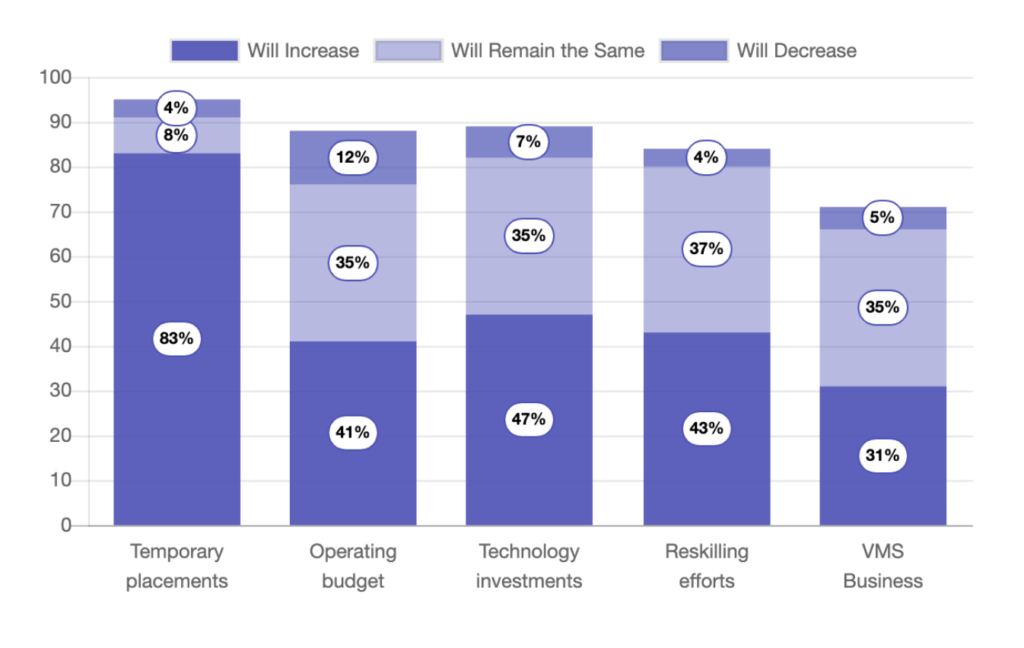
2020 brought both challenges and silver linings to the recruitment industry, according to Bullhorn’s 2021 Global Recruiting Insights and Data (GRID) research.
Bullhorn asked more than 2,200 global recruitment industry professionals what the future holds in five areas:
- Recruitment industry outlook
- Top priorities
- Top challenges
- COVID-19 impact
- Recruitment technology
Overall, while many businesses lost revenue in 2020, the majority feel optimistic about 2021. The pandemic has obviously had a tremendous impact, leading to remote roles undreamed of a year ago. Concurrent with the explosion of remote work is a growing excitement about the possibilities inherent in recruitment technology. Respondents said relationships remain the linchpin, and they plan to build strong ones with both candidates and clients this year.
Let’s dive in.
While two out of five respondents said their revenue decreased in 2020, nearly three-fourths (70%) said they expect revenue to increase in 2021. To help bolster this belief, nearly half of respondents (47%) plan to invest in technology to stay on the industry’s leading edge.

Top priorities
Sourcing top talent (54%) and attracting new clients (45%) are the highest priorities for every region surveyed. Only the UK and Ireland placed winning new clients ahead of recruiting top candidates. It was also the region most likely to report losses last year, which suggests that candidate acquisition is crucial to business success.
Budget constraints and/or hiring freezes make it more challenging for firms to win new client business (32%). Nearly a fourth (23%) add that increased competition also makes it harder to land new accounts.
Optimizing remote work clocks in among the top 10 priorities (11%) — something that wasn’t even on anyone’s radar a year ago.
What gets in the way
The obvious obstacle to success in the past year has been COVID-19 (63%), outstripping talent shortages for the first time in a decade. However, tight talent pools remain a critical challenge (44%), followed by hiring freezes (26%) and economic uncertainty (24%).
Sourcing the right candidates remains the biggest challenge, said 30% of respondents. As a result, many are focusing on providing a positive candidate experience.
Candidate experience concerns also point to where remote work has sometimes meant more obstacle than opportunity. One survey respondent noted this difficulty: “Understanding and therefore articulating client environments when we cannot meet the client face to face.” Another shared this insight: “Not every candidate has access to the same technology options as we do, so that communication can be difficult.”
COVID-19: Will there be a “new normal”?
What is the lasting legacy of the pandemic on the recruitment industry? One-fifth of respondents (20%) said the largest impact will be COVID’s effect on the unemployment rate.
But the most enduring consequence will be the new emphasis on remote work. Remote recruiting (33%), less office space use (25%), and remote onboarding (20%) led the responses. More technology investment came in fourth as a natural result (15%).
The upside? More than half of respondents (56%) said remote jobs will become more common, along with diversification of staffing services and candidate reskilling due to shifting demand.
Digital transformation
The past year has fueled digital adoption as never before. In the wake of COVID-19 and the immediate enforced rise in remote work, 28% of respondents said they’re more likely to adopt a digital transformation strategy. And firms that already use recruitment technology said the pandemic and its aftermath caused them to ramp up their existing digital transformation efforts (35%).
Biggest benefits of digital transformation
- Preparing for the unknown
- Automation allows recruiters and salespeople to provide more “touch”
- Greater efficiency and effectiveness
Biggest obstacles to digital adoption
- Staff not viewing it as an important business tool
- Putting in the work and streamlining the process
- Current employees not being tech proficient
Trends to follow in 2021
Respondents as a group are closely monitoring technology trends, especially those that intersect with digital transformation or the increased role of remote work. It makes sense: 72% are more likely to have a digital transformation strategy in place now than they did a year ago. The message is clear: if you’re not on board the technology train, you’ll be left behind.
Diversity and inclusion also continue to be hot topics, and respondents are keeping an eye on the role of DEI (diversity, equity, and inclusion) efforts in the year ahead.





